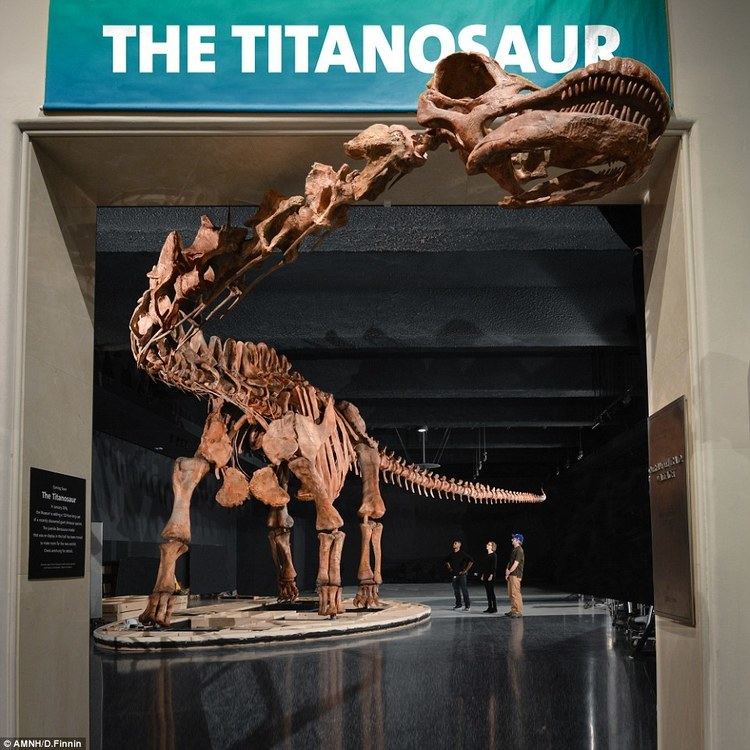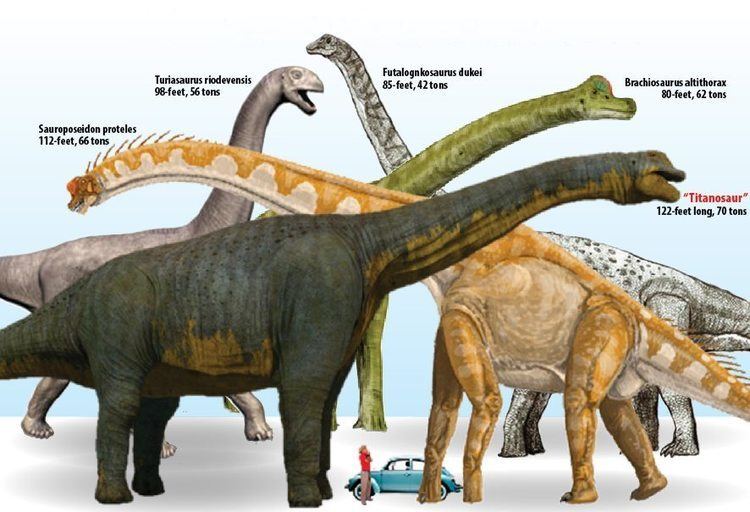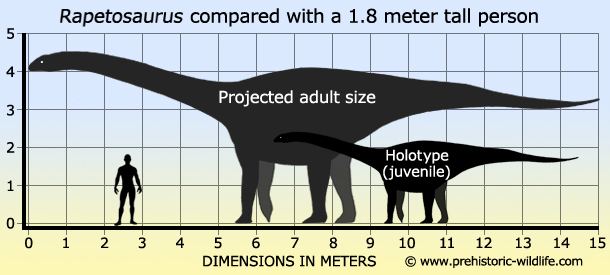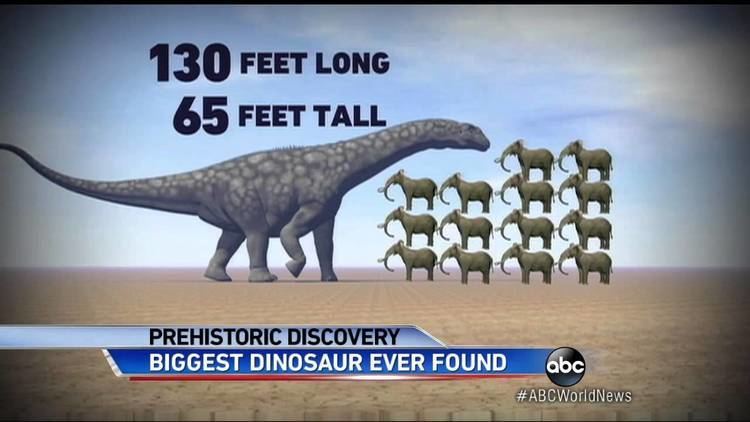Kingdom Animalia Suborder †Sauropodomorpha Clade †Macronaria Scientific name Titanosauria Phylum Chordata | Clade Dinosauria Clade †Neosauropoda Clade †Somphospondyli Higher classification Somphospondyli Order Saurischia | |
 | ||
Lower classifications Argentinosaurus, Antarctosaurus, Pakisaurus | ||
Biggest dinosaur ever found giant titanosaurus discovered in argentina
Titanosaurs (members of the group Titanosauria) were a diverse group of sauropod dinosaurs, which included Saltasaurus and Isisaurus. When the extinction event at the end of the Cretaceous period occurred, they were the last surviving group of long-necked dinosaurs. The group includes some of the heaviest creatures ever to walk the earth, such as Argentinosaurus and Puertasaurus, which are estimated to have weighed up to 90 tonnes (89 long tons; 99 short tons). The group's name refers to the much earlier discovery Titanosaurus, a now dubious genus named for the mythological Titans of Ancient Greece. Together with the brachiosaurids and relatives, titanosaurs make up the larger clade Titanosauriformes.
Contents
- Biggest dinosaur ever found giant titanosaurus discovered in argentina
- World s biggest dinosaur titanosaurus new record 2014
- DescriptionEdit
- DietEdit
- NestingEdit
- RangeEdit
- SystematicsEdit
- TaxonomyEdit
- PhylogenyEdit
- ExhibitsEdit
- References

World s biggest dinosaur titanosaurus new record 2014
DescriptionEdit

Titanosaurs had small heads, even when compared with other sauropods. The head was also wide, similar to the heads of Camarasaurus and Brachiosaurus but more elongated. Their nostrils were large ('macronarian') and they all had crests formed by these nasal bones. Their teeth were either somewhat spatulate (spoon-like) or like pegs or pencils, but were always very small.

Their necks were of average length, for sauropods, and their tails were whip-like, but not as long as in the diplodocids. While the pelvis (hip area) was slimmer than some sauropods, the pectoral (chest area) was much wider, giving them a uniquely 'wide-gauged' stance. As a result, the fossilised trackways of titanosaurs are distinctly broader than other sauropods. Their forelimbs were also stocky, and often longer than their hind limbs. Their vertebrae (back bones) were solid (not hollowed-out), which may be a throwback to more basal saurischians. Their spinal column was more flexible, so they were probably more agile than their cousins and better at rearing up. Unlike other sauropods, some titanosaurs had no digits or digit bones, and walked only on horseshoe-shaped "stumps" made up of the columnar metacarpal bones.

From skin impressions found with the fossils, it has been determined that the skin of many titanosaur species was armored with a small mosaic of small, bead-like scales around a larger scale. One species, Saltasaurus, has even been discovered with bony plates, like the ankylosaurs. Studies published in 2011 also indicate that titanosaurs such as Rapetosaurus (on which the examinations were performed), may have used the osteoderms common in the various genera for storing minerals during harsh changes in climate, such as drought. While they were all huge, many were fairly average in size compared with the other giant dinosaurs. There were even some island-dwelling dwarf species such as Magyarosaurus, probably the result of allopatric speciation and insular dwarfism.

Derived titanosaurs had biconvex vertebrae. The basal condition is either amphiplaty or amphicoely. Venenosaurus may have had a condition intermediate between the two.

The remains of an unnamed Patagonian titanosaur found in Argentina in 2014 are from an animal estimated to have been 40 metres (130 ft) long and 20 metres (66 ft) tall, with an estimated weight of 77 tonnes (76 long tons; 85 short tons), making it among the largest if not the largest identified land animals in Earth's history.
DietEdit

Fossilized dung associated with late Cretaceous titanosaurids has revealed phytoliths, silicified plant fragments, that offer clues to a broad, unselective plant diet. Besides the plant remains that might have been expected, such as cycads and conifers, discoveries published in 2005 revealed an unexpectedly wide range of monocotyledons, including palms and grasses (Poaceae), including ancestors of rice and bamboo, which has given rise to speculation that herbivorous dinosaurs and grasses co-evolved.
NestingEdit
A large titanosaurid nesting ground was discovered in Auca Mahuevo, in Patagonia, Argentina and another colony has reportedly been discovered in Spain. Several hundred female saltasaurs dug holes with their back feet, laid eggs in clutches averaging around 25 eggs each, and buried the nests under dirt and vegetation. The small eggs, about 11–12 centimetres (4.3–4.7 in) in diameter, contained fossilised embryos, complete with skin impressions. The impressions showed that titanosaurs were covered in a mosaic armour of small bead-like scales. The huge number of individuals gives evidence of herd behavior, which, along with their armor, could have helped provide protection against large predators such as Abelisaurus.
RangeEdit
The titanosaurs were the last great group of sauropods, which existed from about 136 to 66 million years ago, before the Cretaceous–Paleogene extinction event, and were the dominant herbivores of their time. The fossil evidence suggests they replaced the other sauropods, like the diplodocids and the brachiosaurids, which died out between the late Jurassic and the mid-Cretaceous Periods.
Titanosaurs were widespread. In December 2011, Argentine scientists announced titanosaur fossils had been found on Antarctica—meaning that titanosaur fossils have been found on all continents. Four well-preserved skeletons of a titanosaur species were found in Italy, a discovery first reported on 2 May 2006. They are especially numerous in the southern continents (then part of the supercontinent of Gondwana). Australia had titanosaurs around 96 million years ago: fossils have been discovered in Queensland of a creature around 25 metres (82 ft) long. Remains have also been discovered in New Zealand. One of the largest ever titanosaur footprints was discovered in the Gobi desert in 2016. One of the oldest remains of this group was found from the Valley of the Dinosaurs, Paraíba state of Brazil, representing a 136-million-year-old subadult individual.
SystematicsEdit
The family Titanosauridae was once used for derived titanosaurs, but Wilson and Upchurch (2003) found the type genus Titanosaurus dubious based on the figures and original description. Weishampel et al., in the second edition of The Dinosauria, also did not use the family Titanosauridae, and instead used several smaller titanosaur families such as Saltasauridae and Nemegtosauridae, coining Lithostrotia for derived titanosaurs. A handful of Argentine sauropod workers, however, continue to use Titanosauridae for titanosaurs now placed in Lithostrotia.
TaxonomyEdit
Family-level taxonomy follows Holtz (2012) unless otherwise noted.
PhylogenyEdit
In the second edition of The Dinosauria, the clade Titanosauria was defined as all sauropods closer to Saltasaurus than to Brachiosaurus. Subsequent cladistic analyses have defined Titanosauria as including Saltasaurus but not Euhelopus or Brachiosaurus.
Relationships within the Titanosauria have historically been extremely variable from study to study, complicated by the fact that clade and rank names have been applied inconsistently by various scientists. One possible cladogram is presented here, and follows a 2007 analysis by Calvo and colleagues. The authors notably used the family Titanosauridae in a broader fashion than other recent studies, and coined the new clade name Lognkosauria.
ExhibitsEdit
- The Field Museum of Natural History, Chicago, has a permanent mount of a real skeleton of a juvenile Rapetosaurus from Madagascar, and a 6'7" right femur of Argyrosaurus from Argentina.
- The American Museum of Natural History has a permanent exhibit of a 37 metres (121 ft) skeleton. The specimen belongs to a species which has not yet been formally named.
- The Naturmuseum Senckenberg in Germany Argentinosaurus huinculensis
- Royal Ontario Museum, Toronto, Canada Futalongkosaurus
